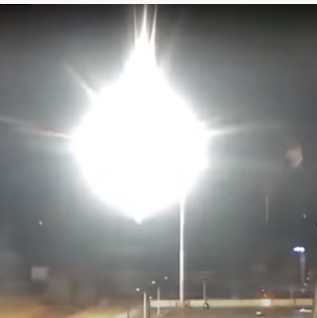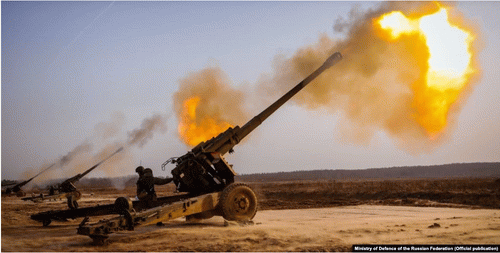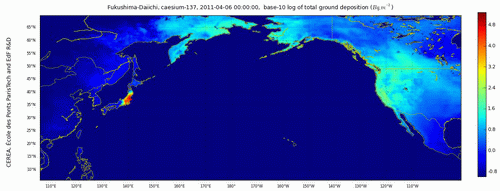A Ukraine nuclear disaster can be stopped even after an attack on a nuclear plant, while the IAEA refusal to act endangers Europe.
IAEA Inaction
Shelling continues to be a danger for the Ukraine, Zaporizhzhia nuclear power plant site, where only one of six nuclear reactor plants is presently operating at the site (click here). The Ukraine government and the IAEA still refuse to answer emails that provide steps to prevent a nuclear disaster if plants are damaged by military attacks to cause an irreparable loss of cooling.
IAEA representatives visited Ukraine this week and could have taken action, but they do not act to stop potential explosions, which may follow such an attack (Figure 1). The International Atomic Energy Agency (IAEA) resistance to new technology can result in the radioactive contamination of Europe.

Figure 1: Previous Artillery Attack That Precipitated Nuclear Disaster Concerns
(Image by Youtube) Details DMCA
Figure 1: Previous Artillery Attack That Precipitated Nuclear Disaster Concerns (click here)
Cover-up of Past Nuclear Disasters
I wrote a series of editorials, based on journal publications, that discuss the U.S cover-up of the 1979 Three Mile Island explosions, and how that cover-up affects Ukraine and other nuclear power plants today. My work to save lives and property has been blocked by major news outlets except for OpEdNews.
Consistently, nuclear industry regulators and the press endorse the suppression of information that will stop the next nuclear power plant explosions. A recent article confronts a potential Ukraine nuclear disaster ("Will We Let a Ukraine Power Plant Explode", Click Here). Robert Leishear on the George Elias Radio Show also confronted the Ukraine nuclear plant explosion dangers (Click Here).
The U.S. NRC cover-up started after the 1979 Three Mile Island explosions, when TMI explosions were greatly feared during the TMI disaster. During the days following this disaster, there was great concern in the press that the TMI plant might explode, where such a large disaster was new to all of us. However, explosions had already ignited inside the reactor buildings.
Under Ronald Reagan, a 1981 Presidential Commission report clearly stated that explosions occurred at TMI. The U.S. NRC chose to ignore this report conclusion, and the NRC then lied for more than forty years to protect the nuclear industry reputation. The U.S. NRC falsely claimed, and still claims, that a fire occurred at TMI ("Blasting into Our Lives - The Three Mile Island Explosion Cover-up: TV, Myth, and Reality", click here).
Lies and Future Nuclear Disasters
This world-wide deceit has misdirected the public, politicians, nuclear industry safety regulators, and nuclear engineers to underestimate the explosion dangers in nuclear plants for decades ("The U.S. NRC Still Fails to Protect Us Against Nuclear Power Plant Explosions Like Fukushima", click here). In fact, this cover-up delayed work that would have prevented the Fukushima explosions and resultant deaths ("We Can Still Prevent Any Widespread Catastrophic Explosions at Ukraine Nuclear Power Plants", click here). Also, the math shows that a Ukraine disaster could fulfil a prediction for the next nuclear power plant explosion before 2039.
A Ukraine Nuclear Disaster?
There is a present risk for widespread radioactive contamination across Europe if coolant is lost to Ukraine reactors during military attacks. Articles in the press dismiss the importance radioactive contamination, by claiming that a Zaporizhzhia disaster would approximate a Fukushima disaster rather than a Chernobyl disaster (click here).
However, radiation maps of the two disasters show that Fukushima radiation levels near Chernobyl and Fukushima only differed by 25 percent (Figures 2 and 3). In that case, the primary difference between radiation dangers is that Fukushima contamination primarily rained down on the Pacific Ocean, and Chernobyl radiation fallout rained down on land areas. Since Chernobyl and Zaporizhzhia are 161.62 miles (260.1 kilometers) apart, the spread of radiation is expected be similar.
Even so, rain and winds dictate where fallout contaminates homes and businesses. Following Fukushima, 165,000 to 195,000 were evacuated. In short, we do not know the scope of this disaster if we let it go out of control to spread radioactive fallout across Europe and/or Russia. One such prediction has been provided by Ukraine to show that as many as 13 countries may be affected (click here), but far more countries were affected by Chernobyl.
Figure 2: Radioactive Contamination Following Chernobyl Explosions (click here)
Figure 3: Radioactive Contamination Following Fukushima Explosions (click here)
Stop Ukraine Nuclear Plant Explosions!
Of great importance to loss of life and radioactive contamination, steps are available to stop such a disaster. We should stop such a disaster! Do you agree?
Shut the Nuclear Plants Down? A Postscript
Another option is to shut the plants down to prevent a nuclear disaster, although reactor cooling during a shutdown needs to considered. Such a recommendation has been mentioned since "The General Staff of Ukraine's Armed Forces said that villages near the plant had been heavily shelled in the 24 hours to Thursday morning from tanks, mortars, barrel and jet artillery (click here)". An important question about the validity of these claims of a Ukraine reactor shutdown concerns the fact that armed Russian military control the plant that is being operated by Ukrainians, and Ukraine may not make that decision.
Even so, reactor operators could be tasked with difficult shutdown decisions, where conditions are deteriorating (click here). Cooling is required to shut down the only operating reactor. For normal operations, other reactors can supply power for pumps. For normal operations, off-site power can run the pumps, but off-site power is reported to be cut off (click here). During off-normal operations, diesels can operate the pumps, but questions about available fuel have been raised. Batteries may be sufficient, but only the operators know for sure. Shutdowns in such conditions are an explosion safety concern.

Figure 4: Although Ukraine Blames Russia and Russia Blames Ukraine, One Type of Russian Artillery is Shown Here
(Image by Russian Government) Details DMCA
Figure 4: Although Ukraine Blames Russia and Russia Blames Ukraine, One Type of Russian Artillery is Shown Here (Click Here)
A Disregard for Lives, Another Postscript
The continuing refusal of the IAEA to even acknowledge communications threatens lives, as fear of a nuclear disaster escalates. In the past days, evacuations around the plant have been urged in response to power plant attacks (Click Here). Multiple articles in the press discuss the UN nuclear disaster concerns (click here). Today, the press further acknowledged radiation dangers to other countries (click here).
Six months ago, concerns about a nuclear disaster were first discussed, but there was little concern in the press (click here). Now, some people even mention World War III if such a nuclear disaster occurs, even though such a claim is unstated by referenced experts (click here). Yet, we still do not know if a European disaster will occur. The only sure things are that a nuclear accident is in our future for nuclear power, and explosions can be prevented.
Although a safety zone around the Zaporizhzhia nuclear plants is being discussed (Click Here), action to prevent a nuclear disaster if attacks continue demands attention (Figure 4). To this end, the following email was sent to the United Nations, the IAEA, the U.S. NRC, the NEA, the ANS, and the U.S. DOE, where responses have not been received.
"I wrote an OpEd News article that was published to the internet". "[A Nuclear Disaster in Europe Can Be Stopped!]. The article opens with the statement that 'A Ukraine nuclear disaster can be stopped even after an attack on a nuclear plant, while the IAEA refusal to act endangers Europe'. I agree that Zaporizhzhia shelling should be stopped, but I emphatically assert that actions should be taken to ensure that operators know what to do in the event of a nuclear [reactor] meltdown to prevent a nuclear power plant explosion disaster if reactor coolant is lost due to a military attack. Comments are welcome".
These agencies, the IAEA in particular, do not care enough about lives to even answer a responsible request for action to stop a nuclear disaster.
(Article changed on Sep 10, 2022 at 8:46 AM EDT)
(Article changed on Sep 11, 2022 at 5:33 AM EDT)






